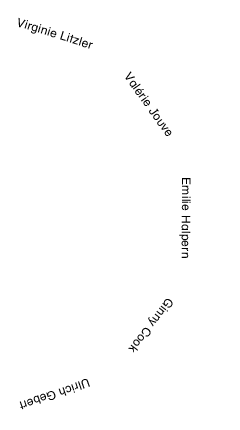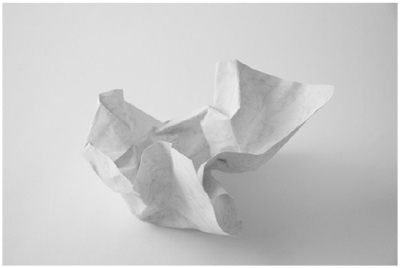
VJ: Peux tu décrire ta première pièce? et la nécessité de la faire.
EH: Ma première oeuvre, dont je me souviens, c’etait un auto-portrait, un dessin. Un grand cercle avec deux yeux, un sourire de travers, et des bras et jambes qui me sortait de la tête. J’avais 3 ans. Je l’ai presenté a ma soeur ainé qui m’a tout de suite demandé : “Il est où le corps?”. It took me a long time to understand her question. The body was there, I was convinced. “Où ça?!” she would express in disbelief, “There!!” I kept repeating pointing at my giant head with legs and arms. But because she was older, wiser, and bigger, I knew she must be right, and the self-doubt began to settle in. There was definitely something missing from my drawing, though I could not see it.
To talk about my first work of art, means talking about some of my first memories. Art didn’t really begin for me, it always was, it began when I began. Both my parents had painters as parents. They met because of art, and I was born because of them. I always knew I’d be an artist, that’s just the way it was. I never questioned it, it was who I was, and what I was born into. Art made me happy, and I loved doing it. It was only a few years ago when I realized that art made me miserable, and that I hated doing it, that I questioned why I had become an artist. It was the first time that I gave myself a choice, and in the end I chose to keep being an artist, but without being miserable.
VJ: Quel est ton rapport quant à l’utilisation de tous ces supports, médias ou objets... comment ce choix s’impose à toi ?
EH: At UCLA, where I studied art as an undergrad, you were expected to study all media from one semester to the next. Drawing was followed by sculpture, followed by painting, followed by photography, followed by video & installation art, and then you started all over again with the advanced classes. I didn’t identify with one particular medium, instead I discovered how each one could represent
a similar idea in a different way. As I got more involved in photography, I grew away from painting, but otherwise I continue to work in sculpture, video, and sound pieces. I will tend to work in waves. Waves of photography are followed by waves of sculpture, in some ways still echoing the semesters of a decade and half ago. Photography has a natural relationship to capturing the fleeting, and the sculptures are the fleeting, they are for the most part ephemeral, and made of found objects.
VJ: Quel est ta relation au langage, au mot?
EH: For a long time I was inspired by pop music, specifically the love song, and the way something so public and even mass-produced could create
an intensely private emotional experience for the listener. I couldn’t figure out how to make the art be like a love song, so I used the lyrics in
the art instead. But I what I learned is language will take over an artwork, and everything else become the text into image. That’s where the photograph “Solar Kiss” came from. It was originally a video of a wooden raft floating in a lake in Maine, and a swimmer came and laid on the raft, and when
the swimmer dove away the water made text appear on the wet wood that said “let me taste the sun”. Lucky for me, I was in grad school at the time,
and one of my professors who was a writer said turn that text into an image, and that’s how “Solar Kiss” was born and text in my art died.
VJ: Beaucoup de monochromie dans ton travail, je ne me souviens pas de ce travail en couleur!!!! Quel est ton rapport à la couleur ?
EH: It’s as if the world has been desaturated so any moment of color is so intense and so heightened.Comme les photos prisent sur la Lune, where the astronauts’ gold face shield radiate contre la paleur du paysage gris.
VJ: La musique ???
EH: Oui la musique!! surtout les chansons d’amour, but what I mean by love songs is what Nick Cave defines as a love song. His process of writing
love songs, which he outlines in his lecture The Secret Lives of Love Songs, echoes what I’m trying to do with my own artistic practice. He describes how all love songs must embrace sadness and contain the potential for pain, because love itself is fleeting. He says that a song that speaks of love without loss or longing, is not a love song but rather a hate song because it denies us of our humanness, robs us of our right to sorrow. The love song writes into existence the ineffable, it endures where the object of the song does not. The desire to explain the indescribable, to make physically palpable what is not there, is where the love song, science, and my work all intersect.
*
(Valérie Jouve also wrote a short piece on the experience of collaborating with both Emilie and Virginie. As with the interview with emilie, we left it in its original french/english version, since that is how the communication took place.)
Une lettre, un jour, pour une exposition. Il y a deux ans, longtemps.
Choisir les oeuvres d’une artiste, avoir mes oeuvres choisies par une autre, mais aucune des trois ne connaît l’autre !!!
Je me suis promenée, sur le site de Emilie Halpern, c’est une démarche qui me semble travailler beaucoup la dimension émotionnelle, sensorielle. J’ai du mal à « sentir » ses oeuvres sur le web …
Elle dit : « Ma première oeuvre, dont je me souviens, c’etait un auto-portrait, un dessin. Un grand cercle avec deux yeux, un sourire de travers, et des
bras et jambes qui me sortait de la tête. J’avais 3 ans. Je l’ai presenté a ma soeur ainé qui m’a
tout de suite demandé : “Il est où le corps?”. It took me a long time to understand her question. The body was there, I was convinced. “Où ça?!” she would express in disbelief, “There!!” I kept repeating pointing at my giant head with legs and arms. But because she was older, wiser, and bigger, I knew she must be right, and the self-doubt began to settle in. There was definitely something missing from
my drawing, though I could not see it.. ».
Cette petite anecdote en dit très long, suffisament …
Virginie Litzler est l’artiste qui doit choisir mon travail. Nous avons eu simplement des échanges téléphoniques, mais le téléphone c’est la voix, la voix qui a un grain, une tonalité, une intensité particulière. Et cette voix que je ne connais pas, dit mes mots, les même mots que moi! Et des mots chargés, je le sens, de la même nécessité. Ce soir là, c’est une rencontre que j’ai faite. Et cette première conversation, remplie du même monde,
va se poursuivre de vive voix, avec l’autre voix.

